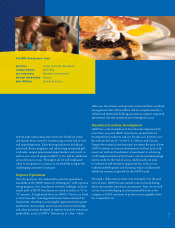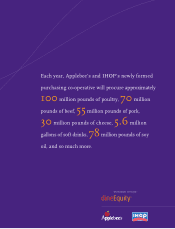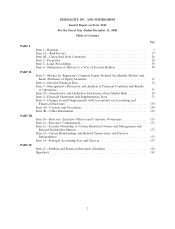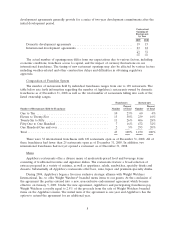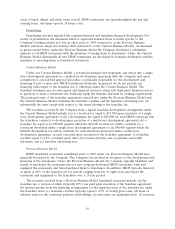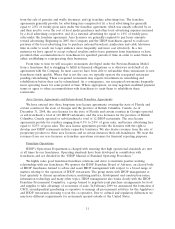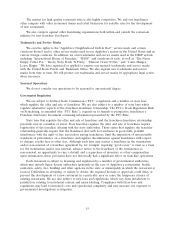IHOP 2008 Annual Report Download - page 19
Download and view the complete annual report
Please find page 19 of the 2008 IHOP annual report below. You can navigate through the pages in the report by either clicking on the pages listed below, or by using the keyword search tool below to find specific information within the annual report.
Franchising
Generally, franchise arrangements consist of a development agreement and separate franchise
agreements for each franchised restaurant. Development agreements grant to the Franchise Developer
the exclusive right to develop Applebee’s restaurants in a designated geographical area over a specified
period of time. The term of a domestic development agreement is generally 20 years. The development
agreements typically provide for an initial development schedule of one to five years as agreed upon by
the Company and the franchisee. At or shortly prior to the completion of the initial development
schedule or any subsequent supplemental development schedule, the Company and the franchisee
generally execute supplemental development schedules providing for the development of additional
Applebee’s restaurants in the Franchise Developer’s exclusive territory.
Prior to the opening of each new Applebee’s restaurant, the franchisee and the Company enter
into a separate franchise agreement for that restaurant. Our standard franchise agreement provides for
an initial term of 20 years and permits renewal for up to an additional 20 years upon payment of an
additional franchise fee. Our current standard franchise arrangement calls for an initial franchisee fee
of $35,000 and a royalty fee equal to 4% of the restaurant’s monthly net sales. We have agreements
with a majority of our franchisees for Applebee’s restaurants opened before January 1, 2000, which
provide for royalty rates of 4% and extend the initial term of the franchise agreements until 2020. The
terms, royalties and advertising fees under a limited number of franchise agreements and other
franchise fees under older development agreements vary from the currently offered arrangements.
We currently require domestic franchisees of Applebee’s restaurants to contribute 2.75% of their
gross sales to a national advertising fund and to spend at least 1% of their gross sales on local
marketing and promotional activities. Under most Applebee’s franchise agreements, we have the ability
to increase the amount of the required combined contribution to the national advertising fund and the
amount required to be spent on local marketing and promotional activities to a maximum of 5% of
gross sales.
We are pursuing a strategy which contemplates transitioning from our current 80% franchised
system to an approximately 98% franchised system. In order to accomplish this strategy we plan to
franchise substantially all of the company-operated Applebee’s restaurants while retaining one company
market in Kansas City. This heavily franchised business model is expected to require less capital
investment, improve margins, and reduce the volatility of cash flow performance over time.
We currently have 75 franchise groups, including 32 international franchisees. We have generally
selected franchisees that are experienced multi-unit restaurant operators. Many franchisees have
operated or concurrently operate other restaurant concepts. Our franchisees operate Applebee’s
restaurants in 44 states in the United States, 15 countries outside of the United States and one U.S.
territory. We have assigned development rights to the vast majority of domestic areas in all states
except Hawaii and the company-operated markets.
As of December 31, 2008, there were 1,470 domestic franchise restaurants. During 2008, 28 new
domestic franchise restaurants were opened, 15 domestic franchise restaurants were closed and 103
company-operated restaurants were refranchised.
International Franchising
We continue to pursue franchising of the Applebee’s concept as the primary method of
international expansion. To this end we seek qualified franchisees that possess the resources needed to
open multiple restaurants in each territory and are familiar with the specific local business environment
in which they propose to develop and operate Applebee’s restaurants. We currently are focusing on
international franchising primarily in Canada, Central and South America, the Mediterranean/Middle
East and Mexico. We currently have 32 international franchisees. As of December 31, 2008, these
5


